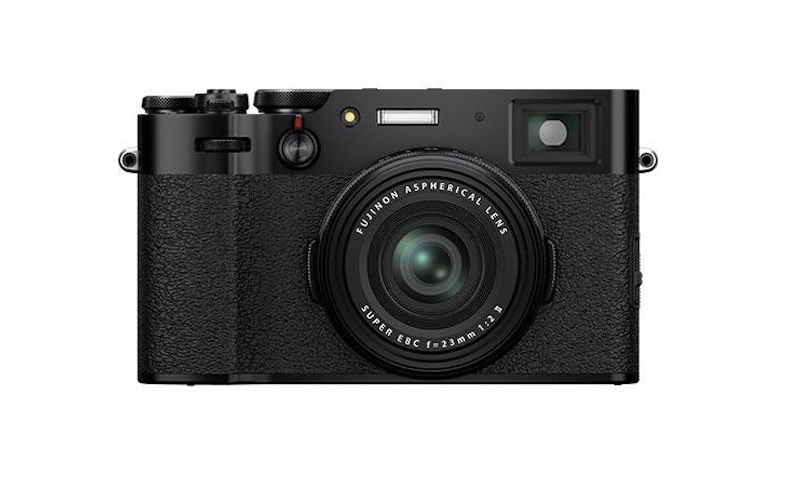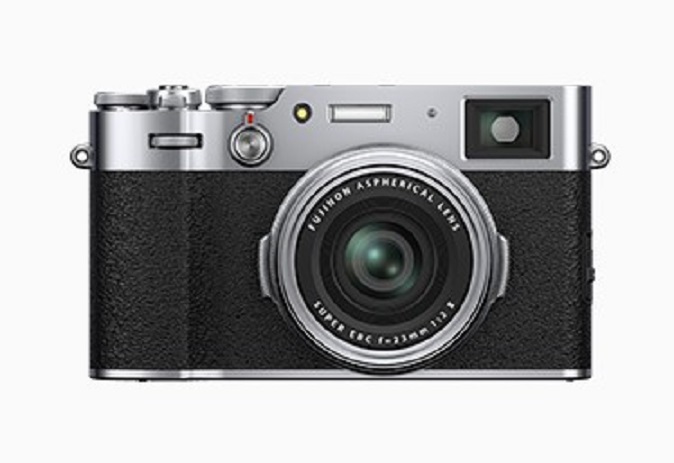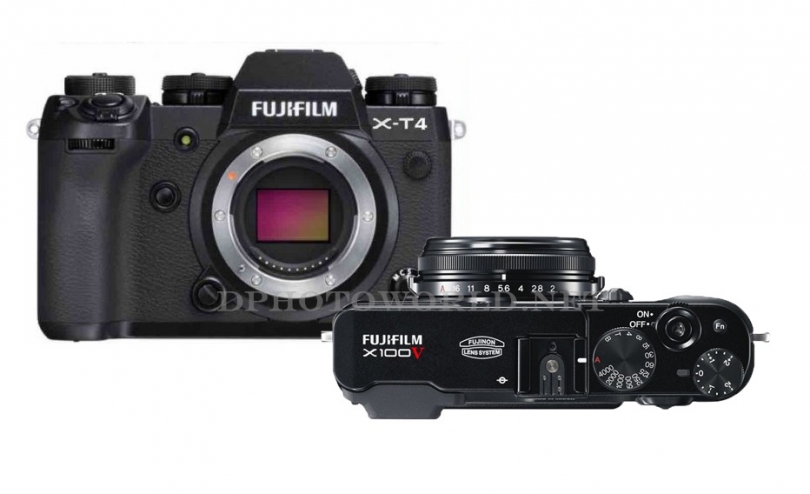
Hands-on with new Fujifilm X100V Fujifilm just updated one of its most important - and most-loved - product lines, with the X100V. That's 'V' pronounced 'vee', but obviously also 'V' as in 'Fifth' (what did the Romans ever do for us?).
The X100V is, of course, the fifth in the X100 line, and to Fujifilm's credit, it still looks a lot like (and works a lot like) the (F)fourth one, which in turn looked a lot like the original X100, released way back in 2011 after a late 2010 announcement.
As you'd expect though, after almost a decade of development, some things have changed. The X100V is an altogether faster, more capable camera than its original ancestor, even though Fujifilm hasn't meddled too much with the basic recipe that has made the X100 series so successful.
Click through this article for a closer look at the new Fujifilm X100V.
New sensor and processor
While the increase in megapixels is modest, the switch from Fujifilm's last-generation 24MP chip to the new 26MP 'X-Trans CMOS 4' sensor used in the X-T3/30 and X-Pro 3 should mean a slight bump in resolution and improved image quality, especially in JPEGs shot at higher ISOs.
It also means that data can be read-out faster, to the tune of an additional three frames per second of continuous shooting. The X100F was no slouch, topping out at 8 fps, but the X100V offers 11fps with the mechanical shutter; switching to the electronic shutter gets you 20 fps with the full sensor, and 30 fps with a 1. 25x crop. These aren't necessarily settings that we suspect many X100V users will activate often, but it's nice to know they're there.
New autofocus system
More useful is an overhauled autofocus system, which in Fujifilm's words offers 'vastly improved' performance compared to previous generations of X100-series cameras. While we haven't tested it yet in depth, there does appear to be a difference in autofocus speed and responsiveness compared to the X100F, which was itself a major improvement over earlier models. Fujifilm claims that the new AF system works down to –5EV, which should constitute a major improvement in low light conditions over previous X100-series cameras.
The difference is most noticeable in face/eye-detection mode, and in continuous tracking. While the X100V is no sports camera (despite its highest frame-rate) it's nice to have a genuinely usable AF-C mode for candid portraiture at wide apertures. As with the X100F, the active autofocus point can be positioned automatically, or manually using the dedicated rear AF joystick.
New-ish lens
While the X100V's 23mm F2, eight element lens might look very similar to that of its predecessors, it has an additional aspherical element in the middle of the design, which according to Fujifilm should give it greater edge resolution and better closeup performance. The previous lens was designed for the 12MP of the original X100, and even on that camera, it didn't look great in the closeup range. With the ever-increasing resolution of the X100-series, Fujifilm really needed to update its lens, and our initial shooting suggests that the company succeeded. We'll be doing detailed side-by-side tests as soon as we can.
The X100V has the same threaded filter / converter ring as all previous X100-series cameras, which means it's compatible with the same wide and tele converters that Fujifilm has been selling for almost a decade. Newer versions (WCL-X100 II and TCL-X100 II) have electrical contacts which tell the camera that a converter is attached, but older (non-II) converters will mount just fine, and are optically identical.
Tilting, touch-sensitive rear LCD
Controversy! We know for a fact that Fujifilm agonized over this one. Should they listen to those loyal X100-series owners who really wanted a tilting and/or touch-sensitive screen, or should they hold firm and honor the purists who didn't want any additional complexity and wanted to keep the camera nice and slim?
In the end, the company tried to do it all, and largely succeeded. The X100V is slightly thicker than the X100F, but not so you'd notice unless you held both in your hand, and even then it's subtle. But room has been made for a proper tilting and touch-sensitive LCD. If you don't need the tilt, that's fine: the unusually thin (4. 4mm) LCD panel sits flush to the back of the camera in its 'normal' position.
Resolution-wise, the 3" LCD has been upgraded from the 1. 04M dots of the X100F to 1. 62M dots. It's a 25% resolution increase in each dimension, and both images and menus do look slightly crisper.
Still too many dials, but fewer custom buttons
I've said it before, and I'll say it again: the X100F was a camera with too many dials. An aperture dial, a shutter speed dial, exposure compensation dial and ISO dial on the top, a push-in control dial on the front, another on the back and control dial around the lens. That's seven dials. Seven dials is too many dials. Right?
Well, clearly I represent the minority view on this issue, since the X100V still has seven dials. What it no longer has, compared to the X100F, is seven customizable buttons. The X100V dispenses with all but two true custom buttons (leaving the one at the hub of the viewfinder mode switch on the front of the camera, and the one to the right of the shutter button on the top) but six additional control points can still be customized. Functions can also be assigned to up/down/left/right swipes of the touch-sensitive LCD.
Still too many dials though.
No 4-way controller
Now that you can assign actions to swiping movements, place AF point by touch, and scroll through captured images by swiping, Fujifilm clearly thought that the old 4-way controller on the rear of the X100F was no longer necessary. As a consequence, the rear of the X100V is now cleaner and less cluttered than its predecessor, but whether the loss of the controller ends up bothering us is something we want to establish as we use the camera more over the coming weeks.
A smaller, but potentially significant change is that the 'Q' button on the right edge of the X100V is now almost flush to the rear of the camera, rather than being raised. This makes it harder to press accidentally, but also potentially harder to press deliberately: especially when wearing gloves. The rearrangements on the rear of the camera have allowed Fujifilm's designers to add a subtle ridge along its right-hand edge, which serves as a modest thumbgrip.
Redesigned ISO dial
It's another a small thing, but whereas in the X100F the ISO dial ring was spring-loaded, so it had to be raised and held there for the ISO dial to be rotated. On the X100V the ring pops up, and must be pushed down again to switch back to shutter speed control. It also gains subtle clicking detents as you select your ISO setting, meaning you have some tactile feedback if you're manipulating the dial with the camera to your eye.
Better? Worse? Let us know in the comments. (We think it's better. )
Redesigned optical viewfinder and OLED EVF
Another feature that Fujifilm claims has been 'vastly' improved, the X100V's optical viewfinder is practically the same as that used in the X-Pro 3. The magnification is essentially the same (~0. 52x) and there's the same small EVF 'tab' option for a more detailed view of exactly what's under your focus point.
The biggest difference from a practical point of view is how Fujifilm has dealt with the issue of parallax. In the X100F, in OVF mode you'll see two center AF reticules, one solid, representing where the selected AF point will fall at infinity, and one with broken edges, to its lower right, which indicates where this point will fall at minimum focus. When AF is acquired you'll see a third box, in green, appear on a line somewhere between these two points (depending on your subject distance).
In the X100V, Fujifilm has simplified this indication, and the infinity reticule is replaced by the 'active' AF point indicator as soon as AF is initiated. As such, if your subject is closer than infinity, it will change position (on a track down and to the right) once focus is acquired. As in the X100F, the main frame lines will also move to indicate accurate framing.
Whether you find this new 'improved' way of dealing with parallax any easier to get your head around probably depends mostly on how you felt about the old way of doing things. It'll take some getting used to, either way.
The EVF has also been upgraded, to a 3. 69m-dot OLED capable of up to 100fps display. The difference between the X100F and X100V EVF experience is fairly subtle, but the panel is more responsive and offers a much greater contrast ratio, which is noticeable in some shooting situations.
4K/30p video
With the X100F, Fujifilm turned the X100 lineup into a halfway-convincing option for videographers, and with the X100V, the company has finished the other half. Offering 4K video at up to 30p, with 10-bit 4:2:2 output over HDMI, and the 'Eterna' cine film profile, the X100V is a much more capable video camera than most buyers will ever need it to be.
Refined body construction and weather-sealing
The X100V is a nicely-built camera, with top and bottom plates formed from single pieces of stamped and cut aluminum. It was not uncommon to hear complaints from X100-series owners that over time, dust would get into their cameras' viewfinders and sometimes even onto the sensor. The X100V offers improved sealing, to the point that with a filter attached to the lens using the optional AR-X100 adapter ring, Fujifilm is confident calling it 'weather-sealed'.
You will need to add that filter, though. Straight out of the box, the X100V may be vulnerable to dust and water incursion, at least around the edges of the lens.
We're told that the main reason that Fujifilm opted not to include a filter adapter in the box (above cost) is that since this is the fifth model in the X100 line, the company is expecting it to be purchased by a lot of photographers upgrading from previous models. As such, a great many of these people will most likely already own the adapter.
Battery and memory card
The X100V features the same NP-W126S battery as the X100V, and it's good for up to 420 shots using the optical viewfinder and 350 using the EVF (per CIPA). The battery is accessed via a door on the base of the camera, and shares space with a single SD card slot, which supports UHS-I media (but not UHS-II).
USB 3. 2 Gen1 (formerly USB 3. 0)
If you're worried about battery life on the go, the X100V offers a USB C interface that supports in-camera charging. It's a USB 3. 2 Gen 1 interface (formerly known as USB 3. 1 Gen 1 and before that as USB 3. 0). The interface does triple duty in fact: charging, data transfer, and audio monitoring using headphones. It sits alongside an HDMI port and a 2. 5mm microphone/remote socket.
So that's the Fujifilm X100V, coming soon to a retailer near you for $1,399 (a $100 premium over older versions). What do you make of it? Let us know.
. dpreview.com2020-2-5 02:00



